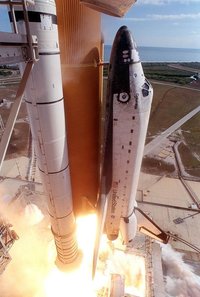Space Shuttle Columbia
|
|
| Space Shuttles |
|
Missing image
Missing image |
Shuttle Orbiter Columbia (NASA Orbiter Vehicle Designation: OV-102) was the first space shuttle in NASA's orbital fleet, first flying mission STS-1 from April 12 to April 14, 1981. On February 1, 2003 Columbia disintegrated during re-entry on its 28th mission, STS-107; all seven crew members aboard were killed.
| Contents |
History
Columbia_landing_on_Rogers_dry_lake.triddle.jpg
Construction began on Columbia in 1975 primarily in Palmdale, California. Columbia was named after the Boston-based sloop Columbia captained by American Robert Gray, which explored the Pacific Northwest and became the first American vessel to circumnavigate the world; the name also honoured Columbia, the Command Module of Apollo 11. After construction, the orbiter arrived at John F. Kennedy Space Center on March 25, 1979 to prepare for its first launch. However, before its first mission, two workers were killed and four injured during a ground test of the orbiter on March 19, 1981.
The first flight of Columbia was commanded by John Young (a space veteran from the Gemini and Apollo eras) and piloted by Robert Crippen, a rookie who had never been in space before, but who served as a support crew member for the Skylab missions and Apollo-Soyuz.
In 1983, Columbia launched the first mission (STS-9) with 6 astronauts, including the first non-American astronaut on a space shuttle, Ulf Merbold. On January 12, 1986 Columbia took off with the first Hispanic American astronaut, Dr. Franklin R. Chang-Diaz. Another first was announced on March 5, 1998 when NASA named their choice of U.S. Air Force Lt. Col. Eileen Collins as commander of a future Columbia mission making Collins the first woman commander of a space shuttle mission.
Final mission

Main article: Space Shuttle Columbia disaster
On its final mission, the craft was carrying the first Israeli astronaut, Ilan Ramon, and the first female astronaut of Indian birth, Kalpana Chawla. Other crew members on the final flight included Rick Husband (commander), Willie McCool (pilot), Michael P. Anderson, Laurel Clark, and David M. Brown.
On the morning of February 1, 2003, the shuttle re-entered the atmosphere after a 16-day scientific mission. NASA lost radio contact at about 9 a.m. EST, only minutes before the expected 09:16 landing at Kennedy Space Center in Florida. Video recordings show the craft breaking up in flames over Texas, at an altitude of approximately 39 miles (63 km) and a speed of 12,500 mph (5.6 km/s).
The collected debris of the vessel are currently stored in decommissioned missile silos at Cape Canaveral Air Force Station.
Flights
Space Shuttle Columbia flew 28 flights, spent 300.74-days in space, completed 4,808 orbits, and flew 125,204,911 miles in total, including its final mission.

| Date | Designation | Notes |
|---|---|---|
| 1981 April 12 | STS-1 | First Shuttle mission |
| 1981 November 12 | STS-2 | First re-use of manned space vehicle |
| 1982 March 22 | STS-3 | Landed White Sands Missile Range |
| 1982 June 27 | STS-4 | Last shuttle R&D flight |
| 1982 November 11 | STS-5 | First 4 person crew |
| 1983 November 28 | STS-9 | First 6 person crew |
| 1986 January 12 | STS-61-C | Congressman Bill Nelson on board |
| 1989 August 8 | STS-28 | Launched KH-11 reconnaissance satellite |
| 1990 January 9 | STS-32 | Retrieved Long Duration Exposure Facility |
| 1990 December 2 | STS-35 | Carried multiple X-ray & UV telescopes |
| 1991 June 5 | STS-40 | 5th Spacelab - Life Sciences-1 |
| 1992 June 25 | STS-50 | U.S. Microgravity Laboratory 1 (USML-1) |
| 1992 October 22 | STS-52 | Deployed Laser Geodynamic Satellite II |
| 1993 April 26 | STS-55 | German Spacelab D-2 Microgravity Research |
| 1993 October 18 | STS-58 | Spacelab Life Sciences |
| 1994 March 4 | STS-62 | United States Microgravity Payload-2 (USMP-2) |
| 1994 July 8 | STS-65 | International Microgravity Laboratory (IML-2) |
| 1995 October 20 | STS-73 | United States Microgravity Laboratory (USML-2) |
| 1996 February 22 | STS-75 | Tethered Satellite System Reflight (TSS-1R) |
| 1996 June 20 | STS-78 | Life and Microgravity Spacelab (LMS) |
| 1996 November 19 | STS-80 | 3rd flight of Wake Shield Facility (WSF) |
| 1997 April 4 | STS-83 | Microgravity Science Laboratory (MSL)- cut short |
| 1997 July 1 | STS-94 | Microgravity Science Laboratory (MSL)- reflight |
| 1997 November 19 | STS-87 | United States Microgravity Payload (USMP-4) |
| 1998 April 13 | STS-90 | Neurolab - Spacelab |
| 1999 July 23 | STS-93 | Deployed Chandra X-ray Observatory |
| 2002 March 1 | STS-109 | Hubble Space Telescope service mission |
| 2003 January 16 | STS-107 | Shuttle destroyed during re-entry on February 1, 2003 and all seven astronauts on board killed. |
Related articles
Columbia_at_Dawn.jpg
External links
- Columbia Loss FAQ (http://www.io.com/~o_m/clfaq/clfaq.htm)
- Orbiter Vehicles (http://science.ksc.nasa.gov/shuttle/resources/orbiters/orbiters.html)
- Shuttle Orbiter Columbia (OV-102) (http://science.ksc.nasa.gov/shuttle/resources/orbiters/columbia.html)
- New York Times coverage of the shuttle (http://www.nytimes.com/2003/02/01/national/01WEB-SHUT.html)
- Scripting News' roundup of links about the shuttle (http://scriptingnews.userland.com/backissues/2003/02/01)
- NVAR and TXAR Infrasound of Explosion of Space Shuttle Columbia (http://geology.heroy.smu.edu/~dpa-www/columbia/)af:Ruimtependeltuig Columbia
de:Columbia (Raumfähre) es:Transbordador espacial Columbia fr:Navette spatiale Columbia he:קולומביה (מעבורת חלל) ja:コロンビア (オービタ) hu:Columbia űrrepülőgép nl:Space Shuttle Columbia no:Columbia (romferge) pl:Columbia pt:Columbia (ônibus espacial) sk:Columbia (raketoplán) sv:Columbia (rymdfärja) zh:哥倫比亞號太空梭
